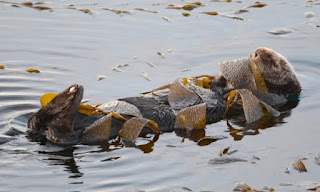BY: NATALIE RAMOS
About the sea otter
There are two distinct sub species of otters in the United States, the Northern sea otter and The Southern sea otter, also known as the California sea otter. The Southern sea otter lives in the waters along the California coastline, ranging from San Mateo County in the north to Santa Barbara County in the south.The sea otter evolved to inhabit a narrow ecological zone leading them to prefer a rocky shoreline with kelp beds.
There are two distinct sub species of otters in the United States, the Northern sea otter and The Southern sea otter, also known as the California sea otter. The Southern sea otter lives in the waters along the California coastline, ranging from San Mateo County in the north to Santa Barbara County in the south.The sea otter evolved to inhabit a narrow ecological zone leading them to prefer a rocky shoreline with kelp beds.
 |
| Sea otters wrap themselves in kelp to keep from floating away |
The sea otter is the smallest species of marine mammals in North America, yet the heaviest member of the weasel family; adults average 65 pounds for male and 45 pounds for female. They average in length at about 4 feet, with their tail accounting for less than one third of their body length. Watch the sea otter live at the Monterey Bay Aquarium here!
Males can live up to 15 years while females can live up to 20 years. Sea otters are the only marine mammal who have no layer of blubber for energy storage, instead air trapped in their dense underfur serves as an insulator from cold water, in fact, sea otters spend hours each day grooming their coats in order to keep it waterproof. Other than primates, sea otters are one of the known mammals to use tools! Sea otters use rocks to open up shellfish.
 |
| Sea otter using a rock to pry open a shellfish |
Watch this cute video to see why otters hold hands
Sea otters are a keystone species! They are critical to maintaining the near-shore kelp ecosystems; without sea otters, the animals sea otters prey on would eat all the kelp, which provides habitat and cover for many other marine animals. Kelp forests are active in capturing carbon in coastal ecosystems, therefore, by keeping kelp forests alive, sea otters are saving other marine animals and reducing levels of atmospheric carbon dioxide, a harmful green house gas.
Population changes
Due to the fur trade in the 1700's, numbers of sea otters plummeted from several hundred thousand down to a total of about 2,000 in the early 1900's; there are currently about 2,150 Southern sea otters living along the coast of central and southern California.
Listing and threats
The southern sea otter species was listed as threatened in 1977 due to its small distribution and potential jeopardy to the remaining habitat and population by oil spills. Besides the harmful toxicity of oil that causes liver and kidney failure, when sea otters' fur comes into contact with oil, it becomes matted which prevents it from insulating the otter; without insulation the sea otters will die from hypothermia. Since listing, white shark bites, pollution and incidental
take in fisheries have also been recognized
as substantial problems. Due to the sea otter's diet which involves sea urchin, lobster, and crab, sea otters often find themselves close to fisherman who view the sea otter as competition and often will intentionally trap them in fishing nets.
What the future holds for the Southern Sea Otter
The main objective is to manage human
activities that may jeopardize the continued existence of the southern sea otter or damage or destroy habitat
critical to its survival. The population goal is 3,000 members, once this number is achieved, the species can be removed from the List of Endangered and Threatened Wildlife. The current population of southern sea otters has remained constant despite the lack of oil spills, which makes it uncertain to determine if sea otters will be delisted. For a complete and detailed version of the recovery plan visit here.
REDUCE YOUR PERSONAL INTERACTION WITH SEA OTTERS!!!!
There is nothing we can do about the white shark attacks because they are also a protected species in California, however reducing your personal interaction with sea otters can have a large impact on their behavior; therefore the next time you are at the beach and you see sea otters stay away! Do not disturb them, otherwise you can be sentenced like this man.
You can help save them, adopt a sea otter today or donate funds through your California tax form.
WORKS CITED
"Basic Facts about Sea Otters." Defenders of Wildlife. N.p., 19 Mar. 2012. Web. 18 Nov. 2015.
Final Revised Recovery Plan for the Southern Sea Otter (Enhydra Lutris Nereis). Portland, Or,: U.S. Fish and Wildlife Service. Region 1, 2003. Web. 18 Nov. 2015.







I think it is interesting that sea otters don't have a layer of blubber for insulation, but instead have air trapped under their dense fur for insulation. I also liked the sea otter web cam, very creative. #BIO227Fall2015
ReplyDeleteThe video of the sea otters holding hands was adorable, and I really enjoyed reading about their ecology and decline. I had no idea that sea otters were members of the weasel family! #BIO227Fall2015
ReplyDelete